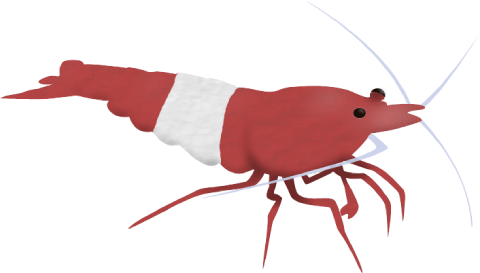Water parameters
- pH
- 6.5 - 8.0
- GH
- 4 - 10
- KH
- 1 - 8
- TDS
- 100 - 180
- Temperature
-
15 - 30 °C
59 - 86 °F
Facts
Difficulty level- Easy
Lifespan- 1 - 2 years
Origin- Taiwan
Adult size- 30 mm / 1.2 inches
Red Rili shrimp are very similar looking to their Red Cherry cousin but have a transparent band around the middle of their bodies. They’re essentially the same shrimp in all other aspects, really a Rili is more of a grade of Cherry shrimp than a separate morph.
Just as with Red Cherries, they belong to the Neocaridina species which is sometimes known as hard water shrimp as they can tolerate relatively high GH and KH levels.
A fully grown adult will also get to around 3 cm (1.2 inches) in size.
Grades
The grading of Red Rili shrimp is pretty similar to that of the Red Cherry.
A higher grade shrimp will have a deep red colour head and tail, with solid coloured legs too. The transparent section should be right in the middle of their bodies and be the only parts of their body that have any hint of translucency - the red parts should be almost totally opaque. The transparent middle should also start and stop with a clean line, not with a fuzzy transition into the red shell.
Lower grades will likely be fairly spotty in colour, have a weaker red or have a small transparent section on their body. The transparent area could also be too large, such as if only the very end of the tail is red, and the rest of the shrimp being almost completely see through.
Female shrimp will typically have the strongest colours and be larger in size, so if you’re trying to move any lower grades into a separate tank for example, double check you’re not only keeping the females.
Care
The Red Rili is quite simple to look after, they’re quite a hardy species. They can usually be expected to live for between 1-2 years in a healthy tank. Their hardiness helps them to grow in a wide variety of water types and conditions. To reduce the odds of unsuccessful molts, aim to keep the KH between 1 and 8, as well as the GH between 4 and 10.
Freshwater dwarf shrimp should be kept in a minimum tank size of 5 gallons (19 liters), however larger tanks of 10 gallons (38 liters) are preferred as it’s easier to control the water parameters with more water.
Unless you live in a very cold climate, Red Rilis don’t require a heater. They should be fine as long as your room stays within the 15-30 °C (59-86 °F) range all year round.
Diet
Generally, all freshwater dwarf shrimp will eat the same types of foods. They’ll spend most of their time scouring the aquarium for biofilm and algae, which will grow on basically all surfaces. If your tank is established and filled with plants, they should have enough natural food to eat.
You can feed your shrimp common foods like algae wafers, bee pollen, shrimp pellets, blanched vegetables, etc. if you’re not sure there’s enough biofilm in the tank.
Offering your shrimp a healthy balanced diet ensures that they get all of the nutrients they require to develop properly and safely molt.
Tank mates
Almost any snail, such as Ramshorn or Nerite snails, may live in the same tank as a group of Red Rili shrimp. Snails also share the shrimp’s desire for harder water, so they can readily obtain all of the minerals they require to produce a strong, healthy shell.
Amano shrimp are frequently chosen as tank mates for Red Rili shrimp. The Amano can grow to be a fair bit larger, and with the different colours and patterns, they stand out from other Neocaridina in the tank. There’s also no risk of interbreeding as they’re a different species that also require brackish water for their young.
Smaller fish, such as Neon Tetras, can occasionally be kept in a shrimp tank. However, there is a chance that the fish would mistake your shrimp for food, so if you want to attempt this, make sure your Red Rilis have lots of hiding spots. As young shrimp are far more likely to be eaten, it’s obviously best not to have any fish sharing their tank if you’re trying to grow the population.
Introducing different colour morphs of the Neocaridina species could cause “wild type” offspring, which are usually mostly translucent with brown spots/stripes. To keep your shrimp colours solid and consistent, you should aim to keep only one colour together at a time.
Find the ideal water parameters and compatible tank mates for Red Rili shrimp.
Breeding
Unlike Caridina shrimp, when different colour Neocaridinas breed together the result is normally a lower-grade copy of one of the parents. The babies could go straight to a very low-grade Red Rili/cherry, or a “wild type” which is mostly translucent with brown spots and stripes.
By consistently culling (i.e. moving to a separate tank) the lower grade Red Rilis, you can gradually improve the grade in your shrimp tank. You’ll need to be patient when trying to improve your grading as there are no guarantees with nature and you could have a mix of grades for quite a while. Distinctive features like the Rili’s transparent band around the body are likely to be passed on to new generations, but even that’s not a certainty.
However, there are a few shrimp breeding tips you can read to try and improve your chances and hopefully speed this “upgrading” process up.


